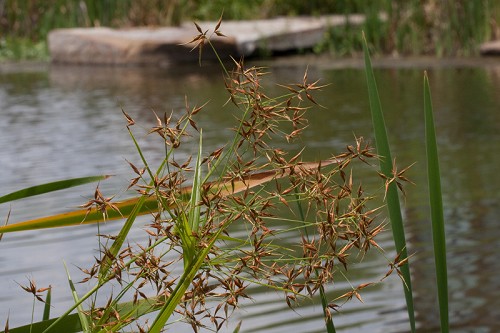Difference between revisions of "Rhynchospora corniculata"
(→Ecology) |
|||
| Line 32: | Line 32: | ||
==Ecology== | ==Ecology== | ||
===Habitat=== <!--Natural communities, human disturbed habitats, topography, hydrology, soils, light, fire regime requirements for removal of competition, etc.--> | ===Habitat=== <!--Natural communities, human disturbed habitats, topography, hydrology, soils, light, fire regime requirements for removal of competition, etc.--> | ||
| − | ''R. corniculata'' proliferates in pondcypress savannas in Carolina bays, swamp forests, and other wetlands. <ref name= "Weakley 2015"> Weakley, A. S. (2015). Flora of the Southern and Mid-Atlantic States. Chapel Hill, NC, University of North Carolina Herbarium. </ref> | + | ''R. corniculata'' proliferates in pondcypress savannas in Carolina bays, swamp forests, and other wetlands. <ref name= "Weakley 2015"> Weakley, A. S. (2015). Flora of the Southern and Mid-Atlantic States. Chapel Hill, NC, University of North Carolina Herbarium. </ref> Specimens have been collected from moist loam, shaded mucky soil, floodplain swamp, shaded river bank, bottomland woods, marshy creekbed, edge of water in dense pine canopy, and upper tidal swamp of mixed forest. <ref name = "FSU herbarium"> URL: http://herbarium.bio.fsu.edu. Last accessed: June 2018. Collectors: Loran C. Anderson, R.K. Godfrey, R.F. Doren, R.Komarek, R.A. Norris, R. Kral, Richard Mitchell, Madel Kral, Sydney T. Bacchus, Deborah R. Shelley, P.L. Redfearn, Sidney T. Brinson, W. Miley, C.S. Giddeen, A. Redmond, K. Craddock Burks, Cecil Slaughter, Annie Schmidt, Travis MacClendon, Chris Buddenhagen, Becky Lee, M. Darst, H. Light, J. Good, L. Peed. States and counties: Florida (Leon, Wakulla, Jefferson, Marion, Gadsden, Liberty, Holmes, Nassau, Jackson, Citrus, Seminole, Escambia, Okaloosa, Madison, Osceola, Santa Rosa, Dixie) Georgia (Atkinson, Thomas)</ref> |
===Phenology=== <!--Timing off flowering, fruiting, seed dispersal, and environmental triggers. Cite PanFlora website if appropriate: http://www.gilnelson.com/PanFlora/ --> | ===Phenology=== <!--Timing off flowering, fruiting, seed dispersal, and environmental triggers. Cite PanFlora website if appropriate: http://www.gilnelson.com/PanFlora/ --> | ||
''R. corniculata'' flowers in July and September. <ref name= "PanFlora"> PanFlora Author: Gil Nelson URL: [http://www.gilnelson.com/PanFlora/ http://www.gilnelson.com/PanFlora/] Date Accessed: 5/29/18 </ref> | ''R. corniculata'' flowers in July and September. <ref name= "PanFlora"> PanFlora Author: Gil Nelson URL: [http://www.gilnelson.com/PanFlora/ http://www.gilnelson.com/PanFlora/] Date Accessed: 5/29/18 </ref> | ||
Revision as of 18:48, 22 June 2018
Common name: short-bristled horned beaksedge [1]
| Rhynchospora corniculata | |
|---|---|

| |
| Photo by John Gwaltney hosted at Southeastern Flora.com | |
| Scientific classification | |
| Kingdom: | Plantae |
| Division: | Magnoliophyta - Flowering plants |
| Class: | Liliopsida – Monocotyledons |
| Order: | Poales |
| Family: | Cyperaceae |
| Genus: | Rhynchospora |
| Species: | R. corniculata |
| Binomial name | |
| Rhynchospora corniculata Lam. | |

| |
| Natural range of Rhynchospora corniculata from USDA NRCS Plants Database. | |
Contents
Taxonomic Notes
Synonyms: Rynchospora corniculata, orthographic variant
Varieties: none
Description
R. corniculata is a perennial graminoid of the Cyperaceae family native to North America. [2]
Distribution
R. corniculata is found in the southeastern corner of the United States. [2]
Ecology
Habitat
R. corniculata proliferates in pondcypress savannas in Carolina bays, swamp forests, and other wetlands. [1] Specimens have been collected from moist loam, shaded mucky soil, floodplain swamp, shaded river bank, bottomland woods, marshy creekbed, edge of water in dense pine canopy, and upper tidal swamp of mixed forest. [3]
Phenology
R. corniculata flowers in July and September. [4]
Fire ecology
R. corniculata is not fire resistant, but has a medium fire tolerance. [2]
Conservation and Management
R. corniculata is listed as threatened by the Indiana Department of Natural Resources Division of Nature Preserves, and as a weedy or invasive species by the Southern Weed Science Society. [2]
Cultivation and restoration
Photo Gallery
References and notes
- ↑ 1.0 1.1 Weakley, A. S. (2015). Flora of the Southern and Mid-Atlantic States. Chapel Hill, NC, University of North Carolina Herbarium.
- ↑ 2.0 2.1 2.2 2.3 USDA Plant Database https://plants.usda.gov/core/profile?symbol=RHCO2
- ↑ URL: http://herbarium.bio.fsu.edu. Last accessed: June 2018. Collectors: Loran C. Anderson, R.K. Godfrey, R.F. Doren, R.Komarek, R.A. Norris, R. Kral, Richard Mitchell, Madel Kral, Sydney T. Bacchus, Deborah R. Shelley, P.L. Redfearn, Sidney T. Brinson, W. Miley, C.S. Giddeen, A. Redmond, K. Craddock Burks, Cecil Slaughter, Annie Schmidt, Travis MacClendon, Chris Buddenhagen, Becky Lee, M. Darst, H. Light, J. Good, L. Peed. States and counties: Florida (Leon, Wakulla, Jefferson, Marion, Gadsden, Liberty, Holmes, Nassau, Jackson, Citrus, Seminole, Escambia, Okaloosa, Madison, Osceola, Santa Rosa, Dixie) Georgia (Atkinson, Thomas)
- ↑ PanFlora Author: Gil Nelson URL: http://www.gilnelson.com/PanFlora/ Date Accessed: 5/29/18